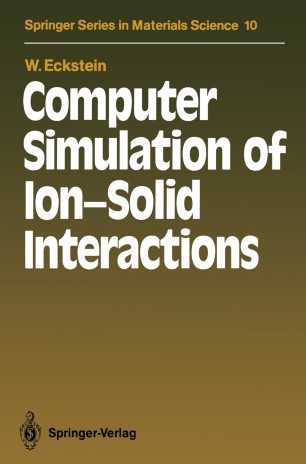TRIM.SP
Table of contents
Introduction
TRIM.SP is an offshoot of the original TRIM program that additionally includes sputtering effects in the simulation of ion implantation. The original citations for the work are:
- Title
- Sputtering studies with the Monte Carlo program TRIM.SP
- Author
- J. P. Biersack, W. Eckstein
- Journal
- Appl. Phys. A
- Volume
- 34
- Issue
- 2
- Pages
- 73-94
- Year
- 1984
- Abstract
-
The Monte Carlo Program TRIM.SP (sputtering version of TRIM) was used to determine sputtering yields and energy and angular distributions of sputtered particles in physical (collisional) sputtering processes. The output is set up to distinguish between the contributions of primary and secondary knock-on atoms as caused by in- and outgoing incident ions, in order to get a better understanding of the sputtering mechanisms and to check on previous theoretical models. The influence of the interatomic potential and the inelastic energy loss model as well as the surface binding energy on the sputtering yield is investigated. Further results are sputtering yields versus incident energy and angle as well as total angular distributions of sputtered particles and energy distributions in specific solid angles for non-normal incidence. The calculated data are compared with experimental results as far as possible. From this comparison it turns out that the TRIM.SP is able to reproduce experimental results even in very special details of angular and energy distributions.
- 10.1007/BF00614759
- Title
- Computer Simulation of Ion-Solid Interactions
- Author
- W. Eckstein
- Series
- Springer Series in Materials Science
- Volume
- 10
- Publisher
- Springer-Verlag
- Address
- Berlin, Heidelberg
- Year
- 1991
- Introduction
-
In this book the author discusses the investigation of ion bombardment of solids by computer simulation, with the aim of demonstrating the usefulness of this approach to the problem of interactions of ions with solids. The various chapters present the basic physics behind the simulation programs, their structure and many applications to different topics. The two main streams, the binary collision model and the classical dynamics model, are discussed, as are interaction potentials and electronic energy losses. The main topics investigated are backscattering, sputtering and implantation for incident atomic particles with energies from the eV to the MeV range. An extensive overview of the literature is given, making this book of interest to the active reseacher as well to students entering the field.
- Cover
- 10.1007/978-3-642-73513-4
- Title
- Backscattering and sputtering with the Monte-Carlo program TRIM.SP
- Author
- W. Eckstein
- Journal
- Radiat. Eff. Defects Solids
- Volume
- 130-131
- Issue
- 1
- Pages
- 239-250
- Year
- 1994
- Abstract
-
The changes of the program TRIM.SP namely the vectorization and other minor changes since its first publication in 1984 are shortly described. Examples especially about backscattering and sputtering illustrate the possibilities which can be handled by the program.
- 10.1080/10420159408219787
The code still sees routine use as a means of calculating μ+ stopping distances in μSR experiments using the LEM facility at PSI. A modified version of the TRIM.SP source code (maintained by the LEM group) can be found at:
- GitLab
- nemu/simulation
- Bitbucket
- zaher-salman/trimsp
- PSI Gitea
- LMU/TRIMSP
Additionally, an online interface to TRIM.SP (with limited simulation capabilities) can be found here.
Caveats
- Bin widths less than 2 Å (e.g., 1 Å) do not behave as intended. I suspect there is a floating-point rounding problem when writing the histogram data to disk…
- The maximum number of bins in the
.rgeoutput is hardcoded in the Fortran source code… - Only up to 5 elements per layer can be simulated!?
- The
TRIM.SPGUI has trouble parsing chemical formulas with non-integer stochiometries. A regex is used to parse the formulas, but devising a pattern that works for all formulae is non-trivial - see e.g.: - The GUI automatically loads coefficients that define the electronic stopping power of the target material (which is an awesome feature) using the tabulated values for protons from ICRU Report 49; however, this compilation is rather dated and even omits a low-energy value for carbon (which has been filled in ad hoc, as discussed here).
